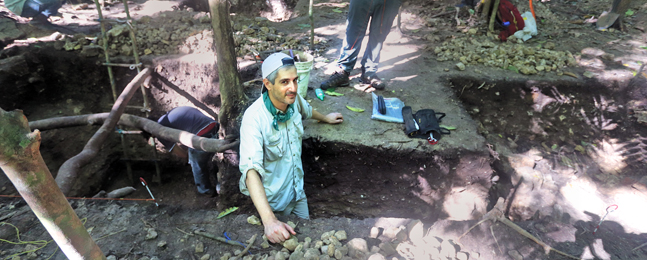Maya Civilization From the Ground Up

Courtesy Charles Golden
Charles Golden
by Lawrence Goodman
When most people think of ancient Maya civilization, they imagine godlike kings building towering pyramids and reveling in bloody human sacrifice. But commoners also played a significant role in the rise and fall of the Mesoamerican civilization, according to associate professor of anthropology Charles Golden.
Along with Brown University bioarchaeologist Andrew Scherer and colleagues from Guatemala and Mexico, Golden has excavated Maya ruins and artifacts from Piedras Negras and Yaxchilan, ancient kingdoms along the Mexico-Guatemala border, for two decades. In areas now covered with ranches, farms or tropical rain forest, the researchers have discovered several dozen previously undocumented sites where everyday people lived and thrived during the height of the Maya empire, in the sixth and seventh centuries.
What they’ve unearthed — defensive walls, pottery, small weapons, weaving tools, inscriptions and human bones — are not as sensational as what’s been found at famous sites like Chichen Itza, Palenque and Tikal. Nevertheless, the discoveries shine new light on the economic and political workings of Maya society, and show that, in addition to the great cities of dynastic kings and queens, small towns and villages played a major role in the empire’s rise and decline.
When Golden and Scherer started their work, they wanted to find out if people living in rural areas thought of themselves as citizens of their kingdom. Although the excavations reveal no notion of citizenship per se, individuals did “feel themselves to be part of a bigger political and economic community,” Golden says. This sense of community was fostered by marketplaces in the cities. Villagers came to buy and sell, transporting goods by canoe or on their backs and heads. In addition, they would journey to the capitals for dances, religious ceremonies and sacrifices.
Golden and Scherer also found that, depending on where they lived, Maya were buried at specific angles. In Piedras Negras, for example, bodies were placed on an axis so that the head pointed 30 degrees east of due north. The axes of the buildings, plazas and processional walkways there ran along the same angle. Golden says it’s a mystery why such specific positioning was chosen.
Dozens of teeth have been found scattered around the Piedras Negras marketplace. Many of the teeth have cavities, suggesting perhaps that the Maya practiced a form of dentistry, pulling teeth in the marketplace.
The Maya civilization’s collapse during the ninth century has long been attributed to warfare, climate change, peasant revolts or foreign invaders. Golden and Scherer argue the society was a victim of its own success. As settlements spread and the king struggled to exercise control over his entire dominion, he appointed nobles to administer in his stead. Gradually, the nobles usurped more and more responsibilities from the king. They even sponsored their own markets and religious festivals. “At some point, people asked themselves, ‘Why do we need the king? We have these local nobles,’” Golden says.
By dispelling myths about the Maya, Golden’s work is bringing them into sharper focus. “They start to seem a lot more familiar to us,” he says.
Golden’s research in 2017 was conducted with support from the Alphawood Foundation of Chicago, the National Science Foundation, Brandeis and Brown.
